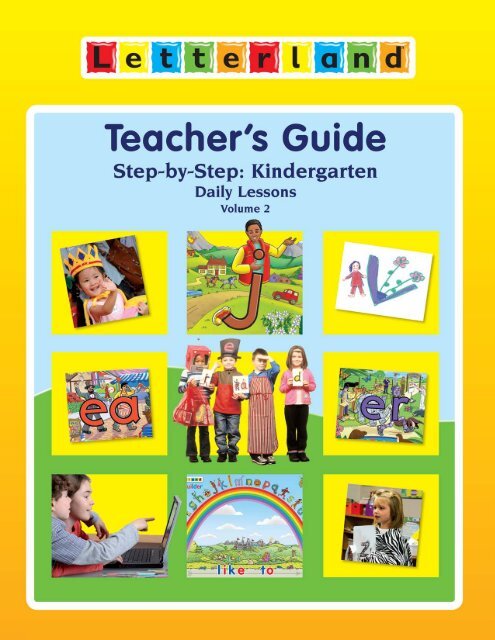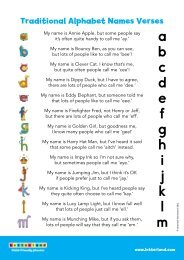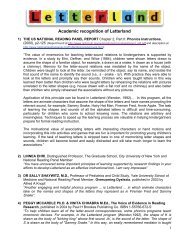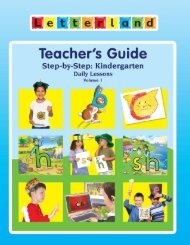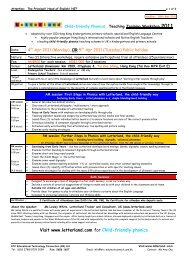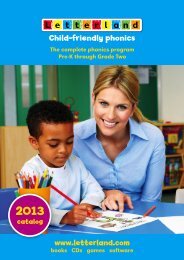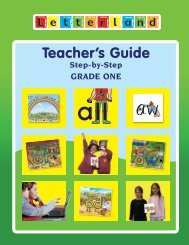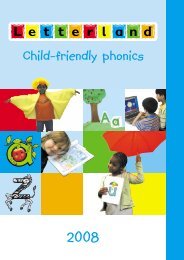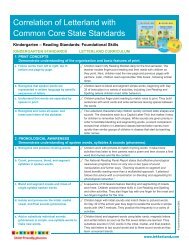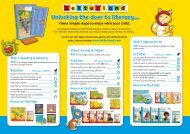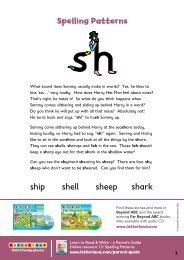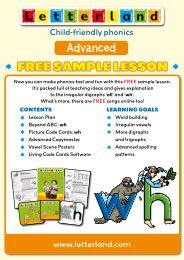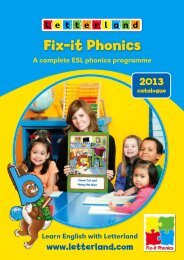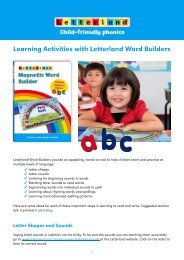Sample Pages - Letterland
Sample Pages - Letterland
Sample Pages - Letterland
- No tags were found...
You also want an ePaper? Increase the reach of your titles
YUMPU automatically turns print PDFs into web optimized ePapers that Google loves.
<strong>Sample</strong> <strong>Pages</strong>Volume 1 covered Section 1: Phonemic Awareness Fast Track (Lessons 1-18) and Section2: a-z Word Building (Lessons 19-87) plus Small Group Intervention.Volume 2 of the full printed guide covers:Section 2. a-z Word Building (Lessons 19-87)Small Group InterventionSection 3. Onsets and RimesSection 4. Consonant Blends (Lessons 138-148)Section 5. Long Vowels and Silent Magic e (Lessons 149-162)Section 6. The Vowel Men Out Walking (Lessons 163-172)Section 7. The Vowel Stealers: r-controlled vowels (Lessons 173-180)Small Group InterventionPlease note:This e-book contains sample pages only - the full printed guide is 245 pages in total.
<strong>Sample</strong> <strong>Pages</strong>The full printed guide is 245 pages in total. This e-book preview contains the followingsample pages:Volume 2 Contents SpreadSection 3:Section 4:Section 5:Section 6:Section 7:Onset and Rimes introductionUnit 3 Word Families with o: Rhyming with op, ot, ockSentence PracticeUnit 8 Introducing R-blendsRead and spell with R-blendsReview R-blendsUnit 10 Magic e make Mr. A appearThe Vowel Men Out Walking introductionUnit 14 Mr. A and Mr. I Out WalkingThe Vowel Stealers introductionUnit 17 Introducing Arthur ArSmall Group Intervention:Continuing your Intervention Lessons from Volume 1Small Group Intervention for Sections 3-7Index to Teacher’s Guide CD2 ContentsPlease note:This e-book contains sample pages only - the full printed guide is 245 pages in total.
<strong>Sample</strong> <strong>Pages</strong><strong>Pages</strong> 97-98Word Families with o<strong>Sample</strong> Lesson 122: Rhyming with op, ot, ock• Review of letter sounds• Live Reading• Vocabulary Cards and rhyming• Small group/independent activities.<strong>Pages</strong> 99-101<strong>Sample</strong> Lesson 123: Sentence Practice• Review onset and rimes for a, i and o• Making words on pocket chart• Word/picture matching• Sentence building• Small group/independent activities.Please note:This e-book contains sample pages only - the full printed guide is 245 pages in total.
© <strong>Letterland</strong> International Limited. All rights reserved./ssss//ock/Live reading m-o-p● Hand out the PCCs listed above.● Line up children with the PCCs to form the word mop.● Have the class sound out the word.Replace o-p with Rime Card op● Have the two children with o and p hold the op Rime Card instead.● Have the class sound out “op,” then “m-op” again.Live reading and Word Cards for -op words● Show the class the mop Word Card and have a child place it on the pocketchart next to the mop picture.● Live read top and hop by changing the first letter.● Add the top and hop cards to the pocket chart next to their pictures.● Each time a word is added to the pocket chart, have the class read all therhyming words in the column.Words with -ot and -ock● Follow the same steps with ot and ock words.● Finally, remove all the Rhyming Pictures and practice reading the Word Cardsusing the Tractors, Trains, Planes, and Helicopters game (see page 80).Vocabulary Cards and rhyming● Show the children the fronts and backs of the Vocabulary Cards, dog and fox.● Point out that the big word in the middle and the words in the corners all havethe same two letters at the end and that they rhyme.● Practice reading the words on the cards with the children.● Ask for volunteers to try reading a few of the words.● Leave the cards out for independent exploration with a few other decodableVocabulary Cards (those with the thin blue frame around the picture). Suggestthat pairs of children explore reading the words when your schedule allows.Small group/independent activities● Picture-coding Provide copies of the large, plain op and display PCCs as amodel. Children picture-code and add rhyming words and pictures around the<strong>Letterland</strong>ers.● Vocabulary Cards One child holds the card and points to the word on theback while the other child reads; then they switch.● Pocket chart/table reading Make words using the op, ot, and ock Rime Cards.Have the children arm-blend the onset and rime.PCCs: h, l, n, s, shRime Cards: op, ot, ockWord Cards: hop, shop; shot, not, lot; lock, sock● Hide-a-Word Display pictures for hot, mop, and lock in a horizontal row.Children take turns matching rhyming Word Cards and hiding them underthe picture. After all Word Cards are hidden, point to a picture and see howmany rhyming words the children can name. Then take the cards out and havechildren read them, one rhyming group of words at a time.98Section 3: Onsets and Rimes: Unit 3
© <strong>Letterland</strong> International Limited. All rights reserved.Unit 3: Lesson 123Sentence Practice✔ Materials• PCCs and Rime Cards: seeReview• Units 1-3 Word Cards: hop,mop, top; lock, rock, sock;dot, hot, pot; chip, hat, map,TG CD 2• Tricky Word Cards: This, is, for,you, • TG CD 2• Rhyming Pictures: hop, mop,top, lock, rock, sock, dot, hot,pot, TG CD 2✔ Preparation• Write chant on chart paper• You may want to use aninteresting rock, or other realitems, in place of pictures forsentence building• Optional: Children’s names oncards for sentence building inwhole class or small group✔ Small group/independent• Copies of large ot for picturecoding,TG CD 2• Additional Word Cards andRhyming Pictures, TG CD 2Review● Word stretching warm up What do all these words tell us about? Say the firstword below, children repeat. One child segments saying each sound, allrepeat. (Mystery answer: The weather.)Words: hot (h-o-t), cool (c-oo-l), wind (w-i-n-d), rain (r-ai-n),snow (s-n-ow)PCCs: ă, g, h, ĭ, l, m, n, p, r, t, w, ch, sh, thRime Cards: op, ot, ock, an, in ap, ig. Play 'Guess Who?' or use the'Handwriting Review' with whole group or small groups (page 242).Rhyming Chant for -op● Practice saying the chant together several times.● Ask which words rhyme.● Underline the rhyming ot words.● Ask the children which two <strong>Letterland</strong>ers maketheir sounds in all four of these rhyming words.● If practical, quickly picture-code Oscar Orange andTalking Tess at the end of each rhyming word.● Ask the children to think of more words thatrhyme with hot (pot, shot, got, not).Hello, I’m Oscar Orange.Can you spot my o sound inwords like hot?Can you spot my o sound inwords like not?Can you spot my o sound inwords like dot,and other words? There reallyare a lot!NonsensethRealMake words on the pocket chartPCCs: d, h, m, r, w, ch, sh, thRime Cards: ot, op, ock, ig, apWords to make: hot, dot, chot*, hop, chop, rock, thock*, shock, wig,hig*, map (*Nonsense words)Make words with PCCs and Rime Cards● Review the latest Rime Cards with the class: op, ot, ock● Make the first word, hot● Arm-blend the word with the children. (Touch the shoulder and say /h/, slidehand down your forearm and say /ot/. Then slide your hand from shoulder towrist and say “hot.”) Continue with the word list as above.Thumbs up for real words, thumbs down for nonsense words● The children give a “thumbs up” for a real word, “thumbs down” for anonsense word.● After children give the sign, write the real words in one list on the board andnonsense words in another list.● Continue with the word list asking individual children to “lead the class” inarm-blending. (The child blends the word first. Then the class blends thesame word.)Section 3: Onsets and Rimes: Unit 3 99
Read the word lists● Read the real and nonsense word lists with the children several times, going alittle bit faster each time.Word/picture matchingWord Cards and Rhyming Pictures: hop, mop, top, lock, rock, sock, dot,hot, potPreparation: Place each group of Rhyming Pictures in a column with spaceto the right of each picture for a Word Card.Match the words with the pictures● Point to the pictures and have children name them.● Hand out the Word Cards. Have children, one at a time, place the wordsbeside the pictures.● Each time a card is placed have everyone read all the words in the same column.Practice reading the words without the pictures● After all the words are placed, remove the pictures, and practice reading thewords together by columns, then by pointing to the words randomly.● Let a few children have turns reading some words on their own.Independent practice● Leave the words and pictures out for children to match up at other timesduring the day.Sentence Building© <strong>Letterland</strong> International Limited. All rights reserved.Word Cards: rock, top, lock, pot, chip, hat, mapTricky Word Cards: This, is, for, youRhyming Pictures: rock, top, lock, pot, chip, hat, mapRead the sentence● Point to the words as you read the sentence aloud.● Point and read it together.● Show everyone the Rhyming Picture of a rock (or an actual rock) and explainthat they will take turns holding the rock picture and pointing to the sentenceand reading the words.Children lead the sentence reading● Give the rock picture to a child and have that child point to the sentence asthe class reads.● Tell the first child to give the rock to a classmate and say, “This rock is for you.”● Repeat with several children. The classmate then leads the rereading of thesentence and passes the rock on to another.Change the words● Change the word in the sentence from rock to top.● The next child leads the reading of the sentence and must pick out the pictureof the top to give to another child.● Substitute other words and let different children lead the reading and deliverthe pictures.100Section 3: Onsets and Rimes: Unit 3
© <strong>Letterland</strong> International Limited. All rights reserved.BrendaJoeVariation: Replace the word you with the children’s names, and deliver thepicture of the rock or top to them.Practice the words● Point in a random order to words in the sentence and have individuals or thewhole class read them.● Pick up the words from the sentence, show them in a random order, and havechildren read them.Small group/independent activities● Picture-coding Provide copies of the large, plain ot and display PCCs as amodel. Children picture-code and add rhyming words and pictures around the<strong>Letterland</strong>ers.● Chant review Let pairs of children reread the ot chant and other previouslyintroduced chants.● Pocket chart/table spelling Call out words for the children to build, using thePCCs and ot, op, and ock Rime Cards. Have the children use word stretchingto segment the words.PCCs: h, l, p, n, s, shRime Cards: op, ot, ockWords: not, lots; pop, shop, hop; lock, locks● Word Card reading Display the words in rhyming columns. Practicereading the words in columns at first as you point. Then point to the wordsrandomly for reading. You may want to use the Tractors, Trains, Planes, andHelicopters activity (see page 80).Thishatsockis forMarcusBrenda● Sentence Building Use name cards for each child in the group. Make asentence such as “This hat is for Marcus.” All read the sentence and thenMarcus picks up the picture of the hat. Then Marcus changes the word “hat” foranother pictured word and replaces his name with another child’s. All read thenew sentence and the named child follows the same steps, and so on until allhave had a turn.Word Cards: pot, top, rock, sock, fan, pan, chip, pin, plus name cards foreach childpotJoeTricky Word Cards: This, is, for, •Picture Cards: pot, top, rock, sock, fan, pan, chip, pinSection 3: Onsets and Rimes: Unit 3 101
<strong>Sample</strong> <strong>Pages</strong><strong>Pages</strong> 151-152<strong>Sample</strong> Lesson 145: Introducing R-blends• Review of letter sounds• Introducing R-blends• Live Reading• fr blend Song• Small group/independent activities.<strong>Pages</strong> 153-154<strong>Sample</strong> Lesson 146: Read and spell with R-blends• Review of letter sounds• Live spelling and Word Cards• dr blend Song• Small group/independent activities.<strong>Sample</strong> Lesson 147: Review R-blends• Songs and gamesPlease note:This e-book contains sample pages only - the full printed guide is 245 pages in total.
© <strong>Letterland</strong> International Limited. All rights reserved.✔✔Unit 8Preparation and materials• PCCs: Review list plus c, p, t• Blends/Digraphs Songs CD, #14• Write the lyrics on sentencestrips or a chart, or prepare forprojection• Make a reversible red/whitemask for Red Robot, or plananother way he can turn fromred to whiteSmall group/independent• Make words for picturecoding,one per page, from theDecodable Word Bank below• <strong>Letterland</strong> Word Builders, orother individual letter sets• Write the lyrics from theabove song, one line for eachsentence stripDecodable Word BankbragbrickbrushcrackcribcrushdressdripdropfreshfroggrabgrassgrinpresstrucktriptrapUnit 8: Lesson 145Introducing R-blendsReview● PCCs ă, b, d, f, g, ĭ, ŏ, r, ŭ, ck, ng, th Use the 'Quick Dash' activity.Introducing R-blends● PCCs for use with the following story: b, c, d, g, l, p, r, t, th● Let’s play a word game while I tell you a story. In some of the words, I willleave out the first sound. I will hold up the Picture Code Card for the firstsound and you say the word correctly. For example, The third little pigmade a house of _ricks (hold up the b PCC). “Bricks.” Here’s anotherone. The baby sleeps in a _rib (hold up the c PCC). “Crib.” All thewords will have Red Robot’s /rrr/ sound as the second sound in the word(display the r PCC) because we are learning about how he often blends hissound with some of our other <strong>Letterland</strong> friends when they start words.● This is the story of Three Billy Goats and Red Robot. You may have heardanother story about some Billy Goats and a bad guy who lived underthe _ridge (Hold up b: “bridge”). He was a _roll (Hold up t: “troll”),but in this story it is Red Robot who lives under the _ridge (b: “bridge”).Red Robot keeps stealing the first letter in words, and that is causing allthe Billy Goats lots of _rouble (t: “trouble”). When the Billy Goats talkabout what they like to eat it comes out _reen _rass (g: “green grass”).And when the Billy Goats go across the _ridge (b: “bridge”) the soundthat they make is all wrong, it sounds like _rip, _rap, _rip, _rap (t: “trip,trap, trip, trap”).● As a matter of fact the Billy Goats couldn’t even say their last name.It came out as Billy Goats _ruff (g:“Gruff”). They couldn’t even sayhow many Billy Goats there were. They kept saying _ree (th: “three”).One day a solution to the Goats’ _roblem (p:“problem”) came in asurprising way. It started to rain.● Red Robot was _rilled (th: “thrilled”). He begin grabbing up first soundsso that the rain went _rip, _rop, _rip, _rop (d: “drip, drop, drip, drop”).But then it started to rain harder and harder, and Red Robot tried to get all ofDippy Duck’s /d/ sounds, but pretty soon his robber sack was all full and hecould not get any more sounds in it.● So from that day on, Red Robot has stopped stealing sounds at the start ofwords. (Occasionally he manages to capture Walter Walrus and steal awayhis sound, but that’s another story.) But he still tries to steal those DippyDuck sounds, so you have to listen really closely when you say drip anddrop because he makes it hard to hear the /d/ sound. And he also still triesto steal the /t/ sound in words like trip and trap, so listen very carefully so youwon’t miss the little /t/ sound in these words.thSection 4: Consonant Blends 151
i b 416 271 i dd 1 17/7/08 16 15 36© <strong>Letterland</strong> International Limited. All rights reserved.Small group/independent activitiesa e i o utruck● Spelling with letter sets Call out the words for children to repeat and thenrubber-band stretch. Children build the words and then spell them aloud (witheyes open or shut). They should leave the previous word in place each timeand decide which letters need to be changed.Letters: ă, b, c, d, ĕ, g, ĭ, ŏ, p, r, s, s, tWords: grab, crab, crib, dress, drop, drip, trip, trap● Sort Word Cards This time lay out the five short vowel PCCs as shown at theleft. Have children take turns sorting Word Cards under the vowels (see the listin the Preparation box). Each time, the child that places the word points to allthe words under that vowel, for all to read.● Sentence Building Build the first sentence and have the children read it withyou. Change the two Word Cards to make the next sentence and let one of thechildren read it. Then have all the children read it. Do the same with the thirdsentence. (Tell them the word rolls.)Words: The, frog, hops, on, the, grass, crab, runs, truck, rollsSentences: The frog hops on the grass.The crab runs on the grass.The truck rolls on the grass.Unit 8: Lesson 147Review R-blends✔✔Preparation and materials• R-Blend Cards: br, dr, gr, tr, TGCD 2• Rime Cards: at, in, ip, op, TG CD 2• Blends/Digraphs Songs CD #17• Project and make copies of'Lesson 144 Word Sort,' TG CD 2Small group/independent• Word Cards: plan, brick, spin,grass, club, drop, step, crush,Do, like, The, frog on, the,grab, truck, hops, runs, rolls,• TG CD 2• Writing materialsReview● PCCs ă, ĕ, ĭ, j, ŏ, p, r, t, ŭ, v, x, y, z, ck Use the 'Quick Dash' activity.Songs and games● Talking Tess and Red Robot Song (Track 17) Read the lyrics to the children.Play the song and have children talk about what they heard in it. Read thelyrics one line at a time to the children and then have them echo-read the linewith you. Let the children highlight the tr blend in words. With the childrenrubber-band stretch the word trip from the story. Help them to hear the /t/sound and the /rrr/ sound in this word as they will tend to hear a /ch/ sound inthis blend. Build this word on the pocket chart and have the children blend iton their arm rollercoasters. Do the same with the words track and trick.● Red Robot Blends Distribute the Blend Cards and the Rime Cards, one perchild (see Preparation box). Display Red Robot’s PCC. We are going to do somelive reading with these Blend Cards and Rime Cards and each word we make willtell us something about Red Robot. Call children to come forward to build a wordby saying the letter names on their cards. For example, for the first word say,We need g-r (letter names) and a-b. Have the children face the class with theircards as in Live Spelling. Have the class sound out the onset /grrr/ and thenthe rime / ăb/ and then the whole word “grab.” Then share the sentence belowthat uses the word. Red Robot likes to grab things with his /rrr/ sound.154Section 4: Consonant Blends
<strong>Sample</strong> <strong>Pages</strong><strong>Pages</strong> 166-167<strong>Sample</strong> Lesson 151: Magic e makes Mr. A appear• Review of letter sounds• Teaching Magic e• Small group/independent activities.Please note:This e-book contains sample pages only - the full printed guide is 245 pages in total.
© <strong>Letterland</strong> International Limited. All rights reserved.Unit 10● Sentence Building Display the Word Cards. Call out each sentence forchildren to build. (Put the cards for can and not close together in the secondsentence to show they make one word.) Let several individual children pointto and read each sentence after it is built.Words: Can, can, we, try, to, fly, in, the, sky, My, my, you, not,But, • , ? , ! , ,Sentences: Can we the ?trytoflyinskyMy the ., my !wewecan tryBut !can not inflyskyUnit 10: Lesson 151Magic e makes Mr. A appear✔✔Preparation and materials• PCCs: Review list plus Magice, a_e (Mr. A with Magic e)• Big PCCs: Annie Apple, Mr. A• Props: Make, or locate a wandto represent Silent Magic e’ssparks (shown below)Small group/independent• Make words for picture-coding,one per page, from the DecodableWord Bank below• Additional PCCs: g, h, l, r• Unit 10 Word Cards: game,chase, drag, gate, flat, brave,wag, platecamegamenameDecodable Word BankgatelateplatelakemaketakeshakemadetradetapeshapegrapevasechasebraveReview● PCCs ă, ā, c, d, m, n, p, s, t, y=ī Use the ‘Quick Dash’ activity.Magic e● Listen first Display Mr. A’s Big PCC up high on the board or pocket chart, andAnnie Apple’s Big PCC down low. Everyone stands up. Tell children this gameis called Up High, Down Low. If they hear Mr. A’s name in a word, they reachboth hands high up in the air. If they hear Annie Apple’s sound, they squatdown low. Say each word and have them repeat it. Tell them to listen for thebeginning sound in these words: actor, ape, acorn, arrow, apron, accident, ace,aim. They can rubber-band stretch these next words to hear the middle sound:cake, made, had, save, take, pack, tape. Alternatively, have children do theAction Tricks for Mr. A and Annie Apple in response to the words.● Pocket chart reading Make the word tap as shown on the following page,with only Annie Apple’s picture side showing. Hide Mr. A’s PCC behind AnnieApple’s PCC. Have the children rollercoaster the word.PCCs: ă, ā, c, n, p, t, Magic e, a_eWords: tap, tape, can, cane● We have been talking about the Vowel Men and about how they are often on theend of little words like go and me. Now let’s look at some other words where wewill find the Vowel Men saying their names. It all started because the Vowel Menwanted to appear in more words. “Why not make up a Naming Game?” said Mr E. IfI can think of a way to make any Vowel Man magically appear in a word, that couldbe a lot of fun! After a lot of hard work, he came up with a very special new kind ofMagic e. He announced it to everyone in <strong>Letterland</strong> like this. Show the picture sideof the Magic e PCC as you say:Introducing the e you cannot hear,with the power to make Vowel Men appear!166Section 5: Long Vowels and Silent Magic e
© <strong>Letterland</strong> International Limited. All rights reserved.● So let’s see how this Magic e works. We put it right here on the end of the wordtap, and it sends its magic sparks over the top of one letter...(Wave your wand infront of the Annie Apple card as you switch the Mr. A card to the front.) ...andmakes Mr. A appear! Now, when we rollercoaster this word, we hear Mr. A sayinghis name. Do we hear this new Magic e? No! It doesn’t make any sound at all. It’sa silent letter. But it does tell us that a Vowel Man has appeared and will be sayinghis name in this word. Let’s put the sounds on our arm and rollercoaster down:“/t/ /ā / /p/, tape.” (Show the a_e PCC.) On this card you can see the magicsparks flying over one letter to make Mr. A appear. There is a blank here becausedifferent letters can go in that space.● The great thing about this Naming Game is that we can always tell when the VowelMen are playing it in a word. We just look out for one of Mr. E’s Magic e at the end.Let’s try another word. Make can on the pocket chart, with Mr. A behind AnnieApple, and use the Magic e, as before, to make Mr. A appear, silently changingthe word to cane.● Live Reading Let’s use the Magic e in Live Reading words. Distribute the PCCs.Give the shaker to the child with Magic e and have the child stand to theaudience’s right of the Live Reading area.PCCs: ă, ā c, d, m, n, p, s, t, Magic eWords: tap-tape, mad-made, Samsame,can-cane● Make tap with the Mr. A child hidingbehind the Annie Apple child. After childrensound out the word, have the Magic e childmove into position at the end of the word,reach over the child with the p, and wavethe magic wand over Annie Apple. Mr. Aand Annie Apple then change places. Havethe class sound out the new word tape.Make each pair of words in the same way,with different children playing the key rolesof Mr. A, Annie Apple, and Magic e.● Demonstrate picture-coding Show children how to picture-code with Magic e onthe board as shown at the left to prepare them for picture-coding on their own.Small group/independent activitiesk● Picture-coding Give children large copies of words from the Decodable Word Bankto picture code.● Pocket chart/table reading Make the words with an empty space for thevowel (e.g. l_ke, h_t) and let children choose Mr. A or Annie Apple to go in theblank. Then have them arm-blend the word.PCCs: ă, ā g, h, l, m, n, p, r, t, Magic eWords: lake, hat, name, shape, trap, grape, nap● Sort Word Cards Display the Annie Apple PCC and the a_e PCC side byside. Have children take turns placing words under the PCC that matchesthe word. Have the child read the word, then point to all the words in thecolumn for all to read.Words: game, chase, drag, gate, flat, brave, wag, plateSection 5: Long Vowels and Silent Magic e 167
<strong>Sample</strong> <strong>Pages</strong><strong>Pages</strong> 186The Vowel Men Out Walking• Introducing ai, ay, ea, ee ,oa, ie and ue• Learning outcomes and assessments at a glance.Page 187<strong>Sample</strong> Lesson 163: Mr A and Mr I Out Walking• Introducing ai• Word building• ai Song• Small group/independent activities.Page 188<strong>Sample</strong> Lesson 164: More with Mr A and Mr I• ai story• Word building• Live spelling• Word Cards• Small group/independent activities.Please note:This e-book contains sample pages only - the full printed guide is 245 pages in total.
© <strong>Letterland</strong> International Limited. All rights reserved.The Vowel Men Out WalkingThe first 10 lessons focus on ‘Vowel Men Out Walking’ to help you teach your children to read andspell words with a long vowel next to a silent vowel such as ai, ea, and oa. There are three units inthis section.Unit 14: Lessons 163-165 ai and ayUnit 15: Lessons 166-167 ea and eeUnit 16: Lessons 168-172 oa, ie, ue and reviewChildren learn that two Vowel Men often go out walking in <strong>Letterland</strong>. When they do, “the first onesays his name but his friend won’t do the same.” The <strong>Letterland</strong> reason: because the second Vowelis the lookout man. He is silent because he is busy looking out for Robots who may try to capturethem. (Section 7 focuses on r-controlled vowels.)Learning about the Vowel Men out WalkingThis section continues with variations on the lively activities from previous sections, but alsoincludes new activities specifically designed to make learning about these long vowel patterns funand memorable.Children learn a Vowels Out Walking Song and sing it withactions and games that help them remember the sounds ofthese letters in words.Children build a ‘train’ of new words in many of theselessons and practice reading these words fluently.They review the new patterns with Live Word Sorting.Learning Outcomes and AssessmentsThere are seven vowel pairs in this section, but childrenlearn them easily because they all work the same way. Theyare reminded of these seven pairs of vowels out walking, bythe Vowels Out Walking Poster, shown below.New Materials from the Teacher’s Guide CDFor this section, you will find new Word Cards for each Unit, and 'WrittenWord Sort' pages for Lessons 171 and 172 on the Teacher’s Guide CD 2.Outcomes Assessments (See page 202)● Read words with a long vowel followed by a silentvowel (e.g, leap, boat)● Spell VV words correctly.1.Word Reading Accuracy2. Spelling Decodable WordsTricky Words● Children are taught to read and spell five additional Tricky Words in this Section:all give some they your186Section 6: The Vowel Men Out Walking
© <strong>Letterland</strong> International Limited. All rights reserved.● You might then play this game as you play the song again: Have one child bea vowel stealing Robot. Mr. A and Mr. I hold their PCC together and turn theirbacks to the class. The Robot hides somewhere in the classroom. Then Mr. Aand Mr. I turn around and begin to walk around the room, Mr. A waving andsaying “A!” while Mr. I leads him as he searches for the Robot. The class canhelp by telling them if they are getting “warmer” or “colder” but they are notallowed to point. The Robot is not allowed to move from the hiding place.When Mr. I tags him he must return to his seat.Decodable Word Bankwaitraintrainnailmaintrailaimraisebaitmailchaingainbraindrainstain,plain,SpainSmall group/independent activities● Picture-coding Give children large copies of words from the Decodable WordBank, to picture-code.● Pocket chart/table reading Make the words below for the children torollercoaster blend. Use the picture side of the PCCs for the vowels and theplain side for the consonants. Let individuals be Blending Leaders by blendinga word first. Then the group blends it. Say a brief sentence with each word.PCCs: ă, b, l, m, p, n, r, s, t, w, aiWords: ran, rain, train, bat, bait, wait, pal, pail, sail● Make a Word Card train Since train is one of our words with Mr. A and Mr. I,let’s make a train across the table as we read our word cards. Each child takesa turn reading a Word Card and adding it to the lengthening train. As eachword is added, the child placing the card points as the group reads thewhole train of words.Word Cards: train, bait, wait, mail, aim, chain, main, trail, plain, nailtrainaim waitbaitchainnailUnit 14: Lesson 164More with Mr. A and Mr. I✔✔Preparation and materials• PCCs: Review list• Beyond ABC book, p 38-39• Unit 14 Word Cards: trap, waits,aim, brat, chain, flag, black,trail, plan, plain, snap, nail, TGCD 2Small group/independent• Character name cards, TG CD 2:Talking Tess, Firefighter Fred• Unit 14 Word Cards: waits, train,rain, bait, fish, TG CD 2• Tricky Word Cards: for, the, the,in, with, his, a, • TG CD 2• <strong>Letterland</strong> Word Builders orother letter sets.Review● PCCs ă, d, g, l, m, n, p, r, t, w, ai Use the 'Quick Dash' activity.Read About Mr. A and Mr. I out walking● Beyond ABC book Read the story to the children (page 38) and explore thepicture with them identifying items with the sound of ai in the middle.Word Building● On the pocket chart I am going to make some words and let you work out whatvowel we hear. Make each word with the plain letter sides of the PCCs. Askchildren to decide which <strong>Letterland</strong>er(s) will be on the other side of the vowel188Section 6: The Vowel Men Out Walking
<strong>Sample</strong> <strong>Pages</strong>Page 204The Vowel Stealers• Introducing ar, er, ir, or and ir• Learning outcomes and Assessments at a glance.Page 205-206<strong>Sample</strong> Lesson 173: Introducing Arthur Ar• Review letters• Introduce ar• Word building• Small group/independent activities.Please note:This e-book contains sample pages only - the full printed guide is 245 pages in total.
The Vowel Stealers© <strong>Letterland</strong> International Limited. All rights reserved.Section 7 The Vowel Stealers includes 8 lessons to help you teach your children about those trickyr-controlled vowels: ar, er, ir, or, and urUnit 17: Lessons 173-176 Arthur Ar and Orvil OrUnit 18: Lessons 177-180 Ernest Er, Urgent Ur, and Irving IrLearning about the Vowel Stealing RobotsThis section continues many of the lively activities from previous sections, but also includes newactivities specifically designed to make learning about r-controlled vowels fun and memorable.The five Vowel Stealing Robots are <strong>Letterland</strong>’s law-breakers. They alert children to the power of theletter r to alter the behavior of any vowel they discover ‘behind a robot’s back’. The robots’alliterativenames cue each new sound, while the Picture Code Cards provide visual clues (Arthur Ar’s radar car,Orvil Or’s boat by the shore, Ernest Er’s running shoes, showing he is the faster runner, Urgent Urwith his boots of curly, purple fur, and Irving Ir with his ink-stained dirty shirt). What with each vowelcaptured and being dragged off in the Robot’s sack, they clearly won’t be making their usual sounds!Children learn to spot these sneaky robots by becoming Reading Detectives, always on the lookout forthose r’s with vowels behind their backs. Each child shows the power of the letter r to control the vowel bydrawing the two letters connected by a simple outline of a sack. The robots are, in fact, great motivators forchildren to get in the habit of looking ahead as they process print, because they love catching the robots inthe act! The same strategy will continue to standthem in good stead when it comes to decodinglarger units of sound such as –air, -ear, -eer, -oar,and –our where the r controls two vowels.Lively songs and stories will strengthen your in teaching of this Section on r-controlled vowels, and alsothe Vowel Stealer Poster with its further visual clues. These include: ar—stars in the dark sky, or—theedge of the shore, er—the ferns, ur—the curb in the curving road, and ir—the bird and a fir tree. (Notethat the robots never bother to mend their nets. That means that the vowels always manage to freethemselves so they can still turn up in lots of other words!)New Materials from the Teacher’s Guide CDYou will find in this section new Word Cards for each Unit (on the Teacher’sGuide CD 2), a short Reading Theater Play, featuring the law-breaking robotsand the days of the week, and a score sheet for Section 7 Assessment.Learning Outcomes and AssessmentsOutcomes Assessments (See pages 220-221)● Read words with r-controlled vowels: ar, er, ir, or, ur1.Word Reading Accuracy● Read high-frequency words with irregular spellings. 2. Cumulative Tricky Word AssessmentTricky Words● Children are taught to read and spell two additional Tricky Words in this Section:are going (Previous Tricky Words are also reviewed.)204Section 7: The Vowel Stealers
© <strong>Letterland</strong> International Limited. All rights reserved.✔✔Unit 17Preparation and materials• PCCs: Review list plus c, f, k,m, n, sh, ar• Beyond ABC book, pages 26-27• Write the sentences on theboard for Word Detectives (orproject)Small group/independent• Write or print words from theDecodable Word Bank, one perpage for children to picturecode.• <strong>Letterland</strong> Word Builders, orindividual letter sets• Unit 17 Word Cards: dark,barn, park, smart, bark, yard,car, harm, star, TG CD 2Decodable Word BankartcarfarfarmbarnparkarmstartpartjarhardcardsmartharmstarbarkdarkyardsharpsharkalarmUnit 17: Lesson 173Introducing Arthur ArReview● PCCs ă, ā, b, d, h, j, y, ai, ay, a_e Use the ‘Guess Who?’ activity.Arthur Ar● Introduce Arthur Ar, the Apple Stealer Beforerevealing the PCC, share this. We all know aboutRed Robot and how he likes to run away withthings that begin with his sound, but did you knowthat there are five other Robots in <strong>Letterland</strong> thatsometimes capture the vowels? Let me show youone of these trouble makers. Show the ar PCCpicture side and write his name to show how itis spelled. This is Arthur Ar, and as you can seehe has captured Annie Apple. Just look at her!How do you think she feels about that? She is veryAll the robots have torn sacks whichthey can’t be bothered to fix, so allthe vowels eventually escape!unhappy because now she is too upset to make her usual sound. What we will hearinstead is Arthur Ar calling out his own last name “Ar!”, using his tiny mobile phonehidden on his outstretched arm to report to his ring leader, Red Robot. Every time hecaptures a talking apple he reports it to Red Robot by saying his last name. Can yousay it with me?..."Ar! Ar!”● Now the tricky thing about the Vowel Stealing Robots is catching them in a word! Theyare trouble-makers for us because they make different sounds. Turn to the plainletter side. Point to the a. When you see this letter, you may think it will be AnnieApple making her usual ‘a’ sound sound, but you need to be a good detective andspot the next letter, because it is a Vowel Stealing Robot! Point to the r. Ah! ha! It’syou, Arthur Ar, and you’re running away with that talking apple and saying your ownname, Ar. Well, you didn’t fool us! Let’s show Arthur Ar that he didn’t trick us by sayinghis name three times as I push his card forward. “Ar, Ar, Ar.”● Let’s see if we can find out more about this <strong>Letterland</strong> Apple Stealer.● Beyond ABC book (pages 26-27) Share the story and picture and let thechildren discover more words with the /ar/ sound. (A full list is on page 47 ofBeyond ABC.)Word Building● On the pocket chart Make the word car with the plain letter sides of thePCCs. Let’s be detectives and see if there is a Vowel Stealing Robot in this word. Doyou see one? Where? Yes, there right after Annie Apple. Good detective work! Turnar to the picture side. We caught you at your robber trick, Arthur Ar! So, is AnnieApple going to be saying her usual sound? “No.” Not while she is stuck behind thatRobot’s back in his net. What sound are we going to hear instead? /ar/. So let’s putthese two sounds on our arm rollercoaster and blend them. “/k/ /ar/, car.”Section 7: The Vowel Stealers 205
i b 416 2 1 i dd 1 1 / /08 16 1 36© <strong>Letterland</strong> International Limited. All rights reserved.b fhardm● Make the rest of the words one at a time with plain letters sides, and for eachword let a child be the ‘chief detective.’ The Chief Detective comes forward andflips the ar card to the picture side to show Arthur Ar that he hasn’t fooledanybody. Then the Chief shows the class how to rollercoaster the word. TheChief repeats this as the class joins in.PCCs: b, c, d, f, h, j, k, m, n, y, ar, shWords: car, card, hard, barn, far, farm, jar, yard, shark● Word Detectives Write the sentences below on the board or project them. Tellthe children that this is an even more challenging detective job because ArthurAr is hiding in several words in these sentences. Have children come forwardand picture-code each ar, roughly as shown at the left. (If you write thesentence large and spread out, several children may be able to picture-code atthe same time.) You may want to make copies of the sentences for each childto picture-code. If time is limited, just have children draw the robber bag fromthe top of the r going around Annie Apple. Then read the sentences with thechildren several times.Arthur Ar parks his radar car in the dark yard.The smart farmer sets his alarm to start his day on time.jshSmall group/independent activitiesfrb y md a r k● Picture-coding Give each child one large ar word from the Decodable WordBank to picture-code.● Reading with individual letter sets Have children first place the letters aand r together and then touch under the two letters and say /ar/. Then say,Place an f (or /fff/) at the beginning of the word. Now, let’s touch the first letter andsay the sound (/f/) and then the a-r together and say /ar/. Now, slide your fingersunderneath and blend the sounds (“ffffar, far”). Guide children in building andblending the remaining words in the same way. (Option: After reading theword, children spell it aloud with eyes shut.)Letters: a, c, d, f, h, j, m, r, s, t, tWords: far, farm, arm, art, start, star, jar, hard, card, car● Word Card Train Give each child a Word Card. Then one at a time, they readtheir words and place them in a train line. Each time a child places a word,that child points to each word in the train from left to right for all to read.Word Cards: dark, barn, park, smart, bark, yard, car, harm, star206Section 7: The Vowel Stealers
<strong>Sample</strong> <strong>Pages</strong><strong>Pages</strong> 222-223Small Group Intervention• Continuing your Intervention Lessons from Volume 1• Reviewing The Five Steps to Intervention• Small group Intervention for Sections 3-7: FAQ.Page 225<strong>Sample</strong> Reading Lesson• Letter Sound ReviewPage 232<strong>Sample</strong> Spelling Lesson• Letter Sounds• Word buiding• Word sorting.Index to Teacher’s Guide CD2 ContentsPlease note:This e-book contains sample pages only - the full printed guide is 245 pages in total.
© <strong>Letterland</strong> International Limited. All rights reserved.Small Group InterventionThe Five Steps1. Letter Sounds2. Beginning Sounds in Words3. Blending and WordRecognition4. Segmentation and Spelling5. Sentences and StoriesContinuing Your Intervention Lessons from Volume 1● The Five Step Intervention Plan from Volume 1 aims to consolidate learningfrom Section 2 which is completed in this volume (Lessons 88-107). The FiveStep Plan is fully explained in Volume 1, pages 192-218. For the letter soundstaught in lessons 88-106, use the lists below in your intervention planning andinstruction. (Lists A, B, and C are in Volume 1, pages 216-217). When childrenhave mastered the objectives of the Five Step Plan, see the Next Steps Plan(page 223) for intervention which correlates with Sections 3-7 in this Volume.Letter Sound, Word, and Sentence Lists for InterventionUsing the <strong>Letterland</strong> SequenceSet D: Using letters from Lessons 88-107Number Vowels Consonants Words SentenceD1ĭ ŏ ŭb f g j m n rw x lljob jog Jim run rug wig fix willJim will run and jog.D2 ă ĕ h n s t v w y ve van have yes yet wet vet Yes, they have a van.D3 ă ĭ ŏ f g n p r x zfox fix zig zag ranfan zip rip nap fogThe fox ran in a zig zag.D4 ă ĭ ŭ d j t y ck qu quit quick quack duck yack Jack The duck made a quick quack.D5D6D7ă ĕ ĭă ĭ ŏ=ŭsilent e*ă ĭ ŭj m n s=z tw ll thc d g h l mn s veb n p r t zck qu thJan jet will well thisjam wet tell tanlove done some come have giverub run quick quit zipzap that quackWill Jan go on this jet?Will you have some jam?That quick cat can zip by so fast.D8 ĕ ĭ f g l p s t v x vet fix pet leg get pig let six set The vet will fix my pet’s leg.* Use the plain letter side of the Magic e PCC.222Small Group Intervention
© <strong>Letterland</strong> International Limited. All rights reserved.Next Steps: Small Group Intervention for Sections 3-7● Next Steps is the plan for Intervention for children who have mastered theskills and strategies of the Volume 1 Intervention Plan, but still need extrapractice to build automaticity in letter sounds and fluency in reading words.This Next Steps Plan begins with the five Word Family Units in Section 3:Onsets and Rimes.● This plan can be used with Sections 4-7 as well. Emphasis is also given toTricky Words (irregular, high frequency words), spelling, reading and writingsentences, and to reading stories and books.Getting StartedWhat is the difference between the Five Step Intervention Plan and the NextSteps Plan?● The Intervention program detailed in Volume 1 is called the Five StepIntervention Plan (see Vol 1, page 192). The Five Step Plan is designed to helpstudents in the very beginning stage of learning letter sounds, learning toblend sounds to read words, and to segment words into phonemes.● The Intervention described here in Volume 2 is designed for students whoknow most letter sounds a-z, but who may still need to build fluency withletter sounds. It is also designed to build fluent word recognition, fluentspelling of regular one syllable words, fluent reading and spelling of irregularhigh-frequency words, and fluent reading and writing of basic sentences andsimple stories.When are children ready to move out of the Five Step Plan and into the NextSteps Plan?● When children know most of the basic letter sounds a-z and can blend andsegment three-sound short vowel words with ease, they may be ready to moveout of the Five Step Intervention Plan. If these children still need more practicethan the majority of the class to master fluent reading of words and the otherskills taught in sections 3-7 of this guide, then they will benefit from smallgroup instruction using the Next Steps Plan.More specific assessments and criteria are provided in the table below to helpyou decide when your children may be ready to begin Next Steps. You mayalso have children who have not been in the Five Step Plan who may benefitfrom Next Steps instruction.MID-YEAR SCORESAssessment (and where to find it)Continue in FiveStep PlanUse Next StepsInterventionRegular curriculumonlyLetter Sounds Fluency (TG CD 2) less than 20 cspm 20-30 cspm 31 cspm or aboveWord Recognition Fluency (TG CD 2) less than 6 cwpm 6-8 cwpm 9 cwpm or aboveSegmentation Accuracy (Assessment 5,Volume 2, pages 39 and 41)less than 15 15-17 sounds 18cspm: correct sounds per minute cwpm: correct words per minuteSmall Group Intervention 223
© <strong>Letterland</strong> International Limited. All rights reserved.● When your children can read the final List (B or C) for the Unit atapproximately 12 correct words per minute, they are ready to move on tothe next Unit. (The criteria are set a bit higher for this task than for the WordReading Fluency Assessment since here the particular words will have alreadybeen practiced a good deal.)● Other criteria to consider are:1) Can the children read and spell the Tricky Words used in the Unit?2) Can they read and write the sentences used in the Unit?Reading LessonStep 1: Letter Sound Review✔Preparation and materials• Picture Code Cards (PCCs) UsePCCs that correspond to wordsin your lesson. Add others yourstudents need• Fast Sounds pages ( TG CD 2)Do I choose the 'Quick Dash' or the 'Fast Sounds' activity, or both?● If your children have not reached the goal of 30 correct sounds per minuteby mid-year (40 cspm by the end of the year) on the Letter Sound Fluency,you will want to use both the Quick Dash with Picture Code Cards and theadditional practice on basic sounds provided by the Fast Sounds activity.● If your children have reached this goal, then you will only need the 'QuickDash' activity. It will provide review of recently introduced sounds and soundsto be used in the lesson.vechQuick Dash● Display 6-10 Picture Code Cards (PCCs) on the table or pocket chart. It ispreferable to show the plain letter side, but if children are unsure of someof the sounds, display the picture side of those PCCs.● Point to each PCC in order and have children say the sound. If somechildren are hesitant or non-responsive with a sound, turn to the PCC tothe picture side and briefly discuss the <strong>Letterland</strong>er or the phonic fablethat explains the sound. Turn back to the plain side and have children saythe sound. Continue practicing sounds with the plain letter sides.● Point to the PCCs in order, repeat three times, a bit faster each time. Thenpoint in random order to the cards and have the children give the sounds.VariationsTaking TurnsHave a child respond individually as you point to several of the PCCs.Quick Dash LeaderLet a child do the pointing to the letters as described above.Small Group Intervention 225
i b i dd / /© <strong>Letterland</strong> International Limited. All rights reserved.Spelling LessonStep 1: Letter Sounds✔Preparation and materials• Picture Code Cards ( PCCs) UsePCCs that match words in yourlesson. Add others needed byyour students• Writing materialsSecret Sounds: Sound-to-letter review with handwriting● Keep the PCCs out of sight. Provide children with writing materials.● Tell the children that the <strong>Letterland</strong>ers like to play a game called 'SecretSounds'. I will keep the pictures of the <strong>Letterland</strong>ers hidden and say their sound. Yourepeat the sound and then write the letter or letters. Then I’ll make the <strong>Letterland</strong>erappear so you can check your answer.● After children write each letter, show the <strong>Letterland</strong>er.● If anyone wrote the wrong letter(s), have them correct it. Repeat the missedPCC after doing a few others.● If anyone formed the letter incorrectly, demonstrate the letter formation. Havethe group practice with air-tracing, or tracing on the table. Have them all writethe letter again. Repeat the missed PCC after doing a few others.Step 2: Word Building✔Preparation and materials• <strong>Letterland</strong> Word Builders, orother letter setsSpelling with Letter SetsChildren segment words to spell● Say the word and have children repeat it.● One of the children segments the word with rubber-bandstretching. Then the other children repeat the stretching.● Children build the word with their letters. Use questioning toguide self-correction of any errors.● After all the children have built the word correctly, they pointto their own letters and say the sounds in unison. Then they slide their fingersunder the letters from left to right and say the word.● If the next word differs from the previous word by only one (or two) letters,have children keep the letters in place as you say the next word. If it differs bymore, have children remove the letters.Step 3: Word Sorting✔Preparation and materials• Copies of the 'Word FamilyRace' page, TG CD 2Word Family Race● This is a variation on the 'Written Word Sort' activity used throughout Sections3-7 of the Teacher’s Guide. Provide each child with a blank copy of the WordFamily Race page (TG CD 2). You may want to laminate the pages, or placethem in clear sheet protectors and use with dry-erase markers.● Have children write the rimes for the three word families across the top row, (e.g.at, an, ap) or in later Units the phonic elements being used (e.g. ai, ee, ar).232Small Group Intervention
© <strong>Letterland</strong> International Limited. All rights reserved.TEACHER’S GUIDE VOLUME 2 CD: List of Contents1 Song Lyrics and VersesAlphabet Song VersesAlphabet Names VersesHandwriting Song VersesBlends & DigraphsConsonant Blend SongsVowel Men SongsMagic e SongVowel Men Out Walking SongVowel Stealers Songs2 Letters for Picture-codingLowercase (plain a-z)Upper-lowercase (plain a-z)Rimes for picture-coding (ap – eck)3 ActivitiesSentence Completion PoemsSpelling BoxesWritten Word Sort worksheetPoster with b d hands4 Reading BookletMy <strong>Letterland</strong> Reading Booklet5 Decodable BookletsThe Queen is SadWhat is in the Box?Is the Hat on the Cat?Can you See?Is this for Me?Fun in the SunDid you See Eddy Elephant?Clever Cat Gets StuckPeter Puppy’s Presents6 PlaysVowel Men Out Walking PlayThe Police and the Vowel Stealers Play7 Assessments and Record SheetsSection 2 Class RecordSection 2 Individual RecordBeginning Sounds in WordsWord Recognition FluencyMatching Capital and LowercaseSection 3 AssessmentSection 3 Class RecordLetter Sound FluencySection 4 AssessmentSection 4 Class RecordSections 3-7 Individual RecordSection 5 AssessmentSection 6 AssessmentSection 7 Assessment8 Word and Picture CardsBeginning Sound PicturesCharacter Name Cards (A – Z)Consonant Blend Cards: s, l, rEssential Words Phrase GameRime Cards (ap, at, an, etc.)Rhyming PicturesTricky Word CardsUnit 1-5 Word CardsUnit 6-8 Word CardsUnit 9-13 Word CardsUnit 14-16 Word CardsUnit 17-18 Word Cards9 Lesson ActivitiesLesson 109 Sentence PracticeLesson 111 Sentence PracticeLesson 112 Onset-Rime SpellingLesson 114 Sentence PracticeLesson 115 Sentence PracticeLesson 119 Sentence PracticeLesson 120 Sentence PracticeLesson 124 Sentence PracticeLesson 125 Written Word SortLesson 126 Sentence PracticeLesson 130 Sentence PracticeLesson 135 Sentence PracticeLesson 140 Sentence PracticeLesson 141 Word SortLesson 143 Sentence PracticeLesson 144 Word SortLesson 147 Word SortLesson 154 Word SortLesson 156 Word SortLesson 159 Word SortLesson 171 Written Word SortLesson 172 Written Word Sort10 Intervention Next StepsNext Steps Lesson LogFast SoundsWord Family HousesNext Steps Word CardsNext Steps Fluency Word ListsReading Robot RacersEssential Words Phrase GameUnit 1-5 Word CardsUnit 6-8 Word CardsUnit 9-13 Word CardsUnit 14-16 Word CardsUnit 17-18 Word CardsSmall Tricky Word CardsWord Family Race


